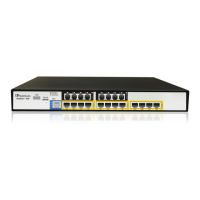To configure the Shared Line feature:
1. In the IP Group table (see 'Configuring IP Groups' on page 210), add a Server-type IP
Group for the BroadWorks server.
2. In the IP Group table, add a User-type IP Group for the IP phone users and set the
'Enable SBC Client Forking' parameter to Yes so that the device forks incoming calls
to all contacts under the same AOR that are registered in the device's registration
database.
3. In the IP-to-IP Routing table (see 'Configuring SBC IP-to-IP Routing' on page 468),
add a rule for routing calls between the above configured IP Groups.
4. In the IP to IP Inbound Manipulation table (see 'Configuring IP-to-IP Inbound
Manipulations' on page 477), add a manipulation rule for the secondary extensions
(e.g., 601 and 602) so that they also register in the device's database under the
primary extension contact (e.g., 600):
• Set the 'Manipulation Purpose' field to Shared Line.
• Set the 'Source IP Group' field to the IP Group ID that you created for the users
(e.g., 2).
• Set the 'Source Username Prefix' field to represent the secondary extensions
(e.g., 601 and 602).
• Set the 'Manipulated URI' field to Source to manipulate the source URI.
• Set the 'Remove From Right' field to "1" to remove the last digit of the extensions
(e.g., 601 is changed to 60).
• Set the 'Suffix to Add' field to "0" to add 0 to the end of the manipulated number
(e.g., 60 is changed to 600).
30.9.3 Call Survivability for Call Centers
The device supports call survivability for call centers. When a communication failure (e.g.,
in the network) occurs with the remote voice application server responsible for handling the
call center application (such as IVR), the device routes the incoming calls received from the
customer (i.e., from the TDM gateway) to the call center agents.
In normal operation, the device registers the agents in its users registration database. Calls
received from the TDM gateway are forwarded by the device to the application server,
which processes the calls and sends them to specific call center agents, through the
device. Upon a failure with the application server, the device routes the calls from the TDM
Gateway to the agents. The device routes the call to the first available user it founds. If the
call is not answered by the user, the device routes it to the next available user. The SBC
can handle a sequence of up to five users, after which the session is timed out and the call
is dropped.

